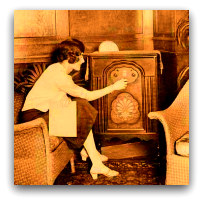 New technologies emerged.
New technologies emerged.
At first this development seemed positive.
There were new programs on the radio and television. More
people heard music through the new technologies than ever before.
Certain musicians proved to be very good teachers within the new
mediums.
Many people were inspired.
Radio and television offered new ways to experience
extraordinary events and entertainment. They were fun and they felt
freer than the traditional entertainment formats. As those technologies
matured, each venue of delivery, called stations or channels, became
focused on its particular genre.
Over time the audiences became equally specialized in their listening habits.
Even movies changed. Instead of having to see them in theaters
people could rent the films and take them home, watch them in pajamas
and make their own popcorn. Much later, they could even see them on
their telephones!
Meanwhile the Internet appeared, offering every conceivable form of
entertainment at the click of a device called a “mouse”. Within a few
decades the Internet had spread across the globe in what was correctly
called a “world-wide web”.
The organizations did not understand how important the technologies were.
They created websites, social networking pages, and email
marketing campaigns, but they had not understood the magnitude of the
ramifications.
Ironically, with the appearance of the Internet, the musical choices
readily available were now increasingly diverse. Just as tastes had
become specialized before, they now became infinitely catholic in
nature.
This was a period when people were very interested
in personal electronic devices. Increasingly they liked to listen to
music alone.
In other words, the new technologies had implications on listening habits, both in terms of content and context.
In terms of personal and societal behavior much had evolved.
Since the organizations didn’t notice the implications, they didn’t make big changes.
They were in great danger, but they could not see it.

Bravo to you, Maestro, for discussing this. I have no idea how your 6-part series will end! It was in the 1970s — when we had the first real explosion of home entertainment in this country — that audiences started to decline. In that decade alone we got cable TV, the VCR and Sony Walkman and, of course, the personal computer.
Ironically (or is it unfortunately?) it was also in the ’70s that we had a huge increase in the number of arts organizations. Why? A large part of the reason was the creation of the NEA in 1964, a good thing, to be sure, but it certainly encouraged lots of people and communities to create new organizations. Of course it’s not just symphony audiences that are down. Attendance is down at rock and jazz concerts, sporting events and — with the exception of the occasional blockbuster like “Avatar” — attendance is down at the movies. (Why go to the movies when you can have a 50″ flat screen TV in your living room?)
I’m guessing that in the next few years we’ll start to see more bookstores closing. Why buy a book when there’s Kindle and the iPad?